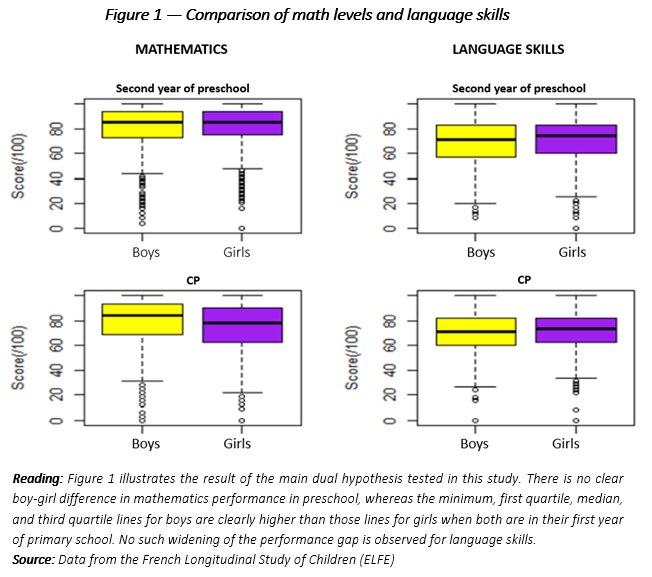Girls’ and boys’ math performance levels in France: at what age does a gap appear?
Press release Published on 09 September 2022
The underrepresentation of girls in mathematics and technology majors and in engineering attests to a kind of “mathematics gap” in favor of boys. The ELFE study (French Longitudinal Study of Children) has enabled researchers to determine for the first time the precise age at which that gap appears: between the ages of 4 and 5, that is, between children’s second year of preschool (out of three in France) and their first year of primary school. This finding is an important step toward better understanding the origins or causes of the gap.
Not likely to be innate
Until recently, debate has centered on whether the observed difference in math performance by sex is innate or societally induced. It is difficult to argue today that it has an entirely innate origin, first because mathematics is fundamentally symbolic and abstract and therefore inaccessible to babies and very young children; second, because when very young children are tested in non-symbolic mathematics, no advantage for boys is observed. It is therefore reasonable to conclude that there is no boy-girl gap before the age of 3 or 4, and to look for its appearance between the ages of 4 and 7. Recent ELFE data has enabled researchers to study the gap—both its presence and possible emergence—across that age range, and so to produce unprecedented research work in this area.
The math gap between girls and boys in France appears around ages 5 and 6
The study produced two significant findings. First, at the age of 4 to 5, there is no gap in favor of boys, and girls actually show a slight advantage. Second, among school children aged 6 to 7, boys are clearly ahead (Figure 1, left side). If we allow that the math gap develops with some regularity, then the age at which it first appears is somewhere between 5 and 6, an range which in France corresponds to the second of three years in preschool and the first year of primary school. Controlling for key variables such as preschool performance level does not weaken—or at least does not efface—the influence of sex for first year of primary school. The emergence of this gap between the sexes at around 5 to 6 years of age is specific to math; no such phenomenon is observed at the same age for language skills, which continue to be stronger among girls (Figure 1, right side).
The difference in math performance between the sexes is an important question for educational and economic policy. Because it advantages one of the two sexes—boys—it can be seen to express a type of inequality between the sexes at school and in society; and because it advantages both young and older male adults later on, it is seen as responsible for the underrepresentation of women in the science, technology, engineering, and mathematics professions of the present and future. We still know relatively little about the origin and causes of the boy-girl mathematics gap. Understanding them is important if we want to escape or overcome that gap.

|
DATA USED The ELFE study (Étude Longitudinale Française de l’Enfance, French Longitudinal Study of Children) follows 18,000 children born in France in 2011 until they turn 20. This is the first such large-scale study of young children’s development—notably their learning processes—ever to be done in France. The publication referenced below analyzes data on over 2,000 ELFE cohort pupils (Figure 1), in addition to 10,000 others, all aged 4 to 7, in their second year of preschool and their first year of primary school. For more information, see: https://www.elfe-france.fr/en/ |
For more information, see:
Jean-Paul Fischer et Xavier Thierry, 2022, Boy’s math performance, compared to girls’, jumps at age 6 (in the ELFE’s data at least), British Journal of Developmental Psychology.
Published in a scientific journal referenced by French national evaluation authorities.








